The automotive thin IGBT module market is valued at USD 118.7 million in 2025 and projected to reach USD 626.5 million by 2035, recording an absolute increase of USD 507.8 million at a CAGR of 18.3%. Growth translates into a 5.3-times expansion over the baseline, but adoption does not unfold evenly across regions. The imbalance in demand highlights Asia as the clear starting point of dominance, Europe as the steady improver, and North America as the late accelerator.
Asia accounts for the largest share at the baseline due to large-scale electric vehicle deployment in China, advanced hybrid platforms in Japan, and strong semiconductor production ecosystems in Korea. The concentration of EV battery plants and government-backed subsidies creates a foundation that cements Asia’s lead. Europe follows with demand supported by emission regulations and electrification mandates in Germany and France. North America remains smaller, with EV growth led by Tesla and early rollouts from GM and Ford, but broader adoption is slower.
By 2030, the automotive thin IGBT module market will expand to USD 272.7 million, adding USD 154.0 million in value. Asia continues to hold more than half of global demand, but its dominance begins to moderate as Europe strengthens. German OEMs expand integration of thin IGBT modules into mainstream EV powertrains, while semiconductor capacity investments improve local sourcing. France and the UK add further weight through electrification incentives. North America gains momentum as EV adoption spreads beyond early innovators, though its share is still behind Europe. Regional imbalance remains tilted toward Asia, but diversification starts to become visible.
By 2035, the total value climbs to USD 626.5 million, with USD 353.8 million added over the previous period. Asia remains the largest contributor, yet relative weight eases as Europe and North America accelerate faster. In Europe, thin IGBT modules are integrated into mid-range EVs as well as premium models, supported by local fab investments and vertically integrated supply chains. North America posts the steepest rise, driven by large-scale EV adoption, government infrastructure incentives, and demand from heavy-duty and pickup vehicle categories. The imbalance that once favored Asia transitions into a more distributed structure, with global adoption spread across all three hubs.
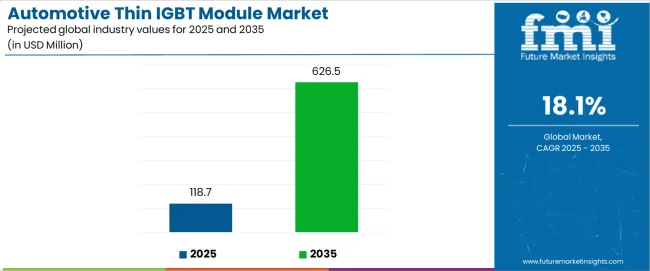
| Period | Primary Revenue Buckets | Share | Notes |
|---|---|---|---|
| Today | 600V to 1200V modules (inverters, DC-DC converters) | 52% | ev traction inverters, hybrid systems |
| Less than 600V modules | 28% | Auxiliary systems, low-power applications | |
| 1200V to 1700V modules | 15% | Commercial vehicles, high-power applications | |
| High voltage systems (1700V+) | 5% | Heavy-duty vehicles, specialty applications | |
| Future (3-5 yrs) | Advanced 600V-1200V systems | 45-48% | Enhanced efficiency, integrated thermal management |
| Next-generation low voltage (<600V) | 18-22% | Smart auxiliary systems, DC-DC conversion | |
| High-power commercial modules (1200V-1700V) | 15-18% | Electric trucks, buses, industrial vehicles | |
| Ultra-high voltage applications (1700V+) | 8-12% | Heavy machinery, grid-tied systems | |
| Integrated power modules | 6-10% | System-on-chip solutions, multi-function units | |
| Custom automotive solutions | 4-7% | OEM-specific designs, specialized applications |
At-a-Glance Metrics
| Metric | Value |
|---|---|
| Market Value (2025) | USD 118.7 million |
| Market Forecast (2035) | USD 626.5 million |
| Growth Rate | 18.1% CAGR |
| Leading Voltage | 600V to 1200V Systems |
| Primary Application | Electric Vehicle Segment |
The automotive thin IGBT module market demonstrates exceptional fundamentals with 600V to 1200V module systems capturing a dominant share through advanced power conversion properties and automotive application optimization. Electric vehicle applications drive primary demand, supported by increasing electrification requirements and automotive industry modernization initiatives. Geographic expansion remains concentrated in developed markets with established automotive infrastructure, while emerging economies show accelerating adoption rates driven by electric vehicle manufacturing initiatives and rising environmental standards.
Primary Classification: The market segments by voltage into less than 600V, 600V to 1200V, 1200V to 1700V, 1700V to 3300V, and more than 3300V, representing the evolution from low-voltage auxiliary systems to high-power traction applications for comprehensive automotive power conversion optimization.
Secondary Classification: Application segmentation divides the automotive thin IGBT module market into electric vehicles (ev), hybrid electric vehicles (Hev), plug-in hybrid vehicles (PHev), and commercial electric vehicles, reflecting distinct requirements for power density, efficiency standards, and thermal management specifications.
Tertiary Classification: End-use segmentation covers automotive OEMs, tier-1 suppliers, power electronics manufacturers, electric vehicle startups, and commercial vehicle producers, while distribution channels span direct sales, automotive distributors, and specialized semiconductor suppliers.
Regional Classification: Geographic distribution covers North America, Latin America, Western Europe, Eastern Europe, East Asia, South Asia Pacific, and Middle East & Africa, with developed markets leading adoption while emerging economies show accelerating growth patterns driven by electric vehicle manufacturing programs.
The segmentation structure reveals voltage progression from traditional low-voltage auxiliary systems toward sophisticated high-power traction applications with enhanced efficiency capabilities, while application diversity spans from passenger electric vehicles to commercial electric trucks requiring precision power conversion solutions.
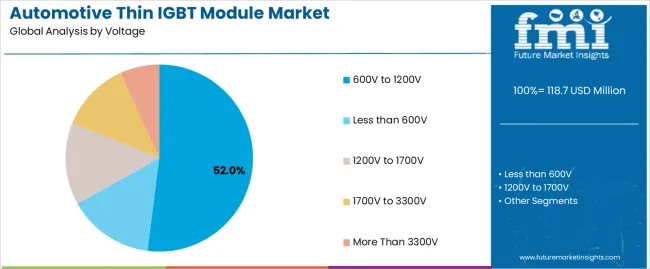
Market Position: 600V to 1200V module systems command the leading position in the automotive thin IGBT market with 52% market share through proven power conversion technologies, including optimized switching performance, thermal efficiency, and automotive reliability optimization that enable vehicle manufacturers to achieve optimal powertrain performance across diverse electric and hybrid vehicle environments.
Value Drivers: The segment benefits from automotive industry preference for proven voltage systems that provide optimal power conversion, thermal management, and operational reliability without requiring ultra-high voltage infrastructure. Advanced IGBT processing features enable enhanced switching efficiency, reduced thermal losses, and integration with existing automotive systems, where power performance and thermal management represent critical operational requirements.
Competitive Advantages: 600V to 1200V module systems differentiate through proven automotive reliability, optimal voltage characteristics, and integration with established automotive power systems that enhance vehicle effectiveness while maintaining optimal performance standards suitable for diverse electric vehicle applications.
Key market characteristics:
Less than 600V module systems maintain a 28% market position in the automotive thin IGBT market due to their auxiliary system advantages and cost-effective positioning benefits. These modules appeal to applications requiring efficient low-power solutions with enhanced reliability profiles for auxiliary vehicle systems. Market growth is driven by electric vehicle expansion, emphasizing auxiliary power solutions and operational efficiency through optimized low-voltage designs.
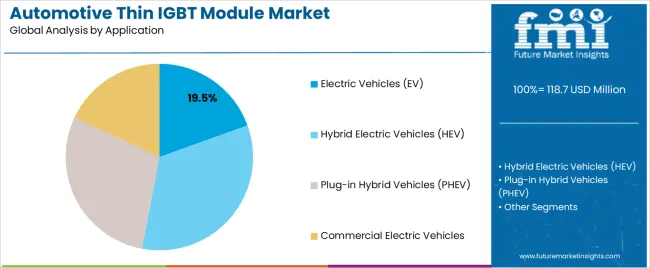
Market Context: Electric vehicle applications demonstrate strong growth in the automotive thin IGBT market with 19.5% CAGR due to widespread adoption of electric powertrains and increasing focus on automotive electrification, operational efficiency, and power conversion applications that maximize module effectiveness while maintaining automotive standards.
Appeal Factors: Electric vehicle manufacturers prioritize module reliability, power conversion consistency, and integration with existing automotive infrastructure that enables coordinated power operations across multiple vehicle systems. The segment benefits from substantial automotive industry investment and electrification programs that emphasize the acquisition of advanced power modules for drivetrain optimization and vehicle performance applications.
Growth Drivers: Electric vehicle expansion programs incorporate thin IGBT modules as essential components for traction inverters, while luxury electric vehicle growth increases demand for module capabilities that comply with automotive standards and minimize operational complexity.
Market Challenges: Varying automotive requirements and thermal management complexity may limit module standardization across different vehicles or power scenarios.
Application dynamics include:
Hybrid electric vehicle applications capture 35% market share through specialized power conversion requirements in hybrid powertrains, plug-in hybrid systems, and automotive applications. These vehicles demand performance modules capable of supporting dual-power requirements while providing power conversion access and operational efficiency capabilities.
Commercial electric vehicle applications account for 18% market share, including electric trucks, buses, and industrial vehicles requiring high-power module capabilities for performance optimization and operational effectiveness.
Market Context: Automotive OEMs dominate the automotive thin IGBT module market with 18.8% CAGR, reflecting the primary demand source for automotive thin IGBT technology in electric vehicle applications and powertrain standardization.
Business Model Advantages: Automotive OEMs provide direct market demand for standardized module systems, driving volume production and cost optimization while maintaining quality control and automotive consistency requirements.
Operational Benefits: Automotive OEM applications include powertrain standardization, cost efficiency, and quality assurance that drive consistent demand for module systems while providing access to latest semiconductor technologies.
| Category | Factor | Impact | Why It Matters |
|---|---|---|---|
| Driver | Electric vehicle adoption & automotive electrification (government mandates, environmental regulations) | ★★★★★ | Growing electric vehicle market requires advanced power modules with enhanced efficiency capabilities and thermal management properties proven effective across automotive applications. |
| Driver | Power density advancement & efficiency requirements (thermal management, power conversion) | ★★★★★ | Transforms module requirements from "basic power switching" to "optimized power conversion"; manufacturers that offer high-efficiency modules and thermal features gain competitive advantage. |
| Driver | Automotive performance market growth & electrification excellence (luxury evs, performance vehicles) | ★★★★☆ | Premium electric vehicles need distinctive, high-performance modules; demand for exclusive and superior power solutions expanding addressable market. |
| Restraint | Cost pressures & automotive pricing constraints (especially for mass market vehicles) | ★★★★☆ | Mass market vehicle manufacturers defer module upgrades; increases price sensitivity and slows premium module adoption in cost-conscious automotive markets. |
| Restraint | Alternative power electronics competition (silicon carbide, gallium nitride alternatives) | ★★★☆☆ | Advanced semiconductor alternatives offer superior performance characteristics and efficiency gains, potentially limiting thin IGBT adoption in next-generation applications. |
| Trend | Semiconductor technology integration & performance enhancement (switching speed, thermal management) | ★★★★★ | Advanced semiconductor properties, efficiency optimization, and thermal analytics transform operations; technology integration and performance enhancement become core value propositions. |
| Trend | Integration & automotive-specific solutions (OEM partnerships, custom designs) | ★★★★☆ | Custom modules for specific automotive applications; specialized designs and targeted automotive capabilities drive competition toward integration solutions. |
The automotive thin IGBT module market demonstrates varied regional dynamics with Growth Leaders including China (24.4% growth rate) and India (22.6% growth rate) driving expansion through electric vehicle manufacturing initiatives and automotive electrification programs. Steady Performers encompass Germany (20.8% growth rate), Brazil (19.0% growth rate), and developed regions, benefiting from established automotive industries and power electronics adoption. Mature Markets feature United States (17.2% growth rate), United Kingdom (15.4% growth rate), and Japan (13.6% growth rate), where automotive advancement and electrification requirements support consistent growth patterns.
Regional synthesis reveals East Asian markets leading adoption through electric vehicle expansion and automotive technology development, while North American countries maintain steady expansion supported by module technology advancement and automotive electrification requirements. European markets show strong growth driven by automotive applications and efficiency integration trends.
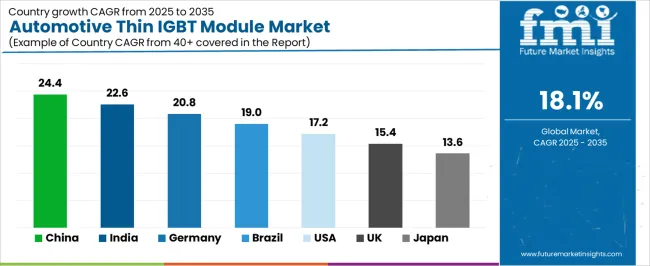
| Region/Country | 2025 to 2035 Growth | How to win | What to watch out |
|---|---|---|---|
| China | 24.4% | Focus on high-volume automotive production solutions | Regulatory changes; local semiconductor competition |
| India | 22.6% | Lead with cost-effective manufacturing capabilities | Import restrictions; automotive quality barriers |
| Germany | 20.8% | Provide premium automotive-grade modules | Over-regulation; lengthy automotive approvals |
| Brazil | 19.0% | Offer value-oriented automotive solutions | Currency fluctuations; automotive import duties |
| United States | 17.2% | Push automotive integration technology | Automotive compliance costs; scaling challenges |
| United Kingdom | 15.4% | Focus on premium automotive applications | Economic impacts; automotive module costs |
| Japan | 13.6% | Emphasize precision automotive manufacturing | Traditional automotive preferences; adoption rates |
China establishes fastest market growth through aggressive electric vehicle development programs and comprehensive automotive electrification expansion, integrating advanced thin IGBT module systems as standard components in electric vehicle facilities and automotive installations. The country's 24.4% growth rate reflects government initiatives promoting electric vehicle infrastructure and domestic semiconductor capabilities that mandate the use of advanced power module systems in automotive and electric vehicle facilities. Growth concentrates in major automotive hubs, including Beijing, Shanghai, and Shenzhen, where electric vehicle development showcases integrated module systems that appeal to automotive manufacturers seeking power conversion optimization capabilities and electrification applications.
Chinese manufacturers are developing cost-effective module solutions that combine domestic production advantages with advanced semiconductor features, including enhanced efficiency control and improved thermal capabilities. Distribution channels through automotive suppliers and semiconductor distributors expand market access, while government support for electric vehicle development supports adoption across diverse automotive and powertrain segments.
Strategic Market Indicators:
In Mumbai, Delhi, and Bangalore, automotive facilities and electric vehicle manufacturers are implementing advanced thin IGBT module systems as standard equipment for power conversion and electrification optimization applications, driven by increasing government automotive investment and electric vehicle modernization programs that emphasize the importance of power efficiency capabilities. The automotive thin IGBT module market holds a 22.6% growth rate, supported by government automotive initiatives and electric vehicle development programs that promote advanced module systems for automotive and electric vehicle facilities. Indian manufacturers are adopting module systems that provide consistent power conversion performance and efficiency features, particularly appealing in urban regions where automotive electrification and operational excellence represent critical business requirements.
Market expansion benefits from growing automotive capabilities and international electric vehicle partnerships that enable domestic production of advanced module systems for automotive and electric vehicle applications. Technology adoption follows patterns established in automotive electronics, where reliability and efficiency drive procurement decisions and operational deployment.
Market Intelligence Brief:
Germany's advanced automotive market demonstrates sophisticated thin IGBT module deployment with documented power effectiveness in electric vehicle applications and automotive facilities through integration with existing automotive systems and powertrain infrastructure. The country leverages engineering expertise in semiconductors and automotive systems integration to maintain a 20.8% growth rate. Automotive centers, including Bavaria, Baden-Württemberg, and Lower Saxony, showcase premium installations where module systems integrate with comprehensive automotive platforms and vehicle management systems to optimize power conversion and operational effectiveness.
German manufacturers prioritize system quality and automotive compliance in module development, creating demand for premium systems with advanced features, including automotive integration and power conversion systems. The automotive thin IGBT module market benefits from established automotive infrastructure and a willingness to invest in advanced module technologies that provide long-term operational benefits and compliance with international automotive standards.
Market Intelligence Brief:
Brazil's market expansion benefits from diverse automotive demand, including electric vehicle modernization in São Paulo and Rio de Janeiro, automotive facility upgrades, and government automotive programs that increasingly incorporate advanced module solutions for powertrain applications. The country maintains a 19.0% growth rate, driven by rising electric vehicle activity and increasing recognition of advanced module benefits, including precise power control and enhanced operational effectiveness.
Market dynamics focus on cost-effective module solutions that balance power conversion performance with affordability considerations important to Brazilian automotive manufacturers. Growing automotive industrialization creates continued demand for modern module systems in new automotive infrastructure and facility modernization projects.
Strategic Market Considerations:
United States establishes market leadership through comprehensive automotive programs and advanced electric vehicle infrastructure development, integrating thin IGBT module systems across automotive and electric vehicle applications. The country's 17.2% growth rate reflects established automotive industry relationships and mature module technology adoption that supports widespread use of advanced module systems in automotive and electric vehicle facilities. Growth concentrates in major automotive centers, including Michigan, California, and Texas, where module technology showcases mature deployment that appeals to automotive manufacturers seeking proven power capabilities and electrification efficiency applications.
American automotive providers leverage established distribution networks and comprehensive technical support capabilities, including design programs and training support that create customer relationships and operational advantages. The automotive thin IGBT module market benefits from mature regulatory standards and automotive requirements that mandate module system use while supporting technology advancement and operational optimization.
Market Intelligence Brief:
United Kingdom's automotive market demonstrates integrated thin IGBT module deployment with documented power effectiveness in electric vehicle applications and automotive facilities through integration with existing automotive systems and powertrain infrastructure. The country maintains a 15.4% growth rate, supported by automotive excellence programs and power effectiveness requirements that promote advanced module systems for automotive applications. Automotive facilities across England, Scotland, and Wales showcase systematic installations where module systems integrate with comprehensive automotive platforms to optimize power conversion and operational outcomes.
UK automotive providers prioritize system reliability and industry compatibility in module procurement, creating demand for validated systems with proven power features, including efficiency monitoring integration and power conversion systems. The automotive thin IGBT module market benefits from established automotive infrastructure and excellence requirements that support module technology adoption and operational effectiveness.
Market Intelligence Brief:
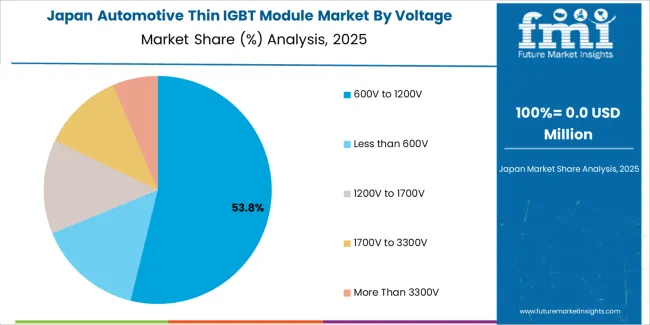
Japan's market growth benefits from precision automotive demand, including advanced electric vehicle facilities in Tokyo and Osaka, quality integration, and automotive enhancement programs that increasingly incorporate module solutions for power applications. The country maintains a 13.6% growth rate, driven by automotive technology advancement and increasing recognition of precision module benefits, including accurate power control and enhanced automotive outcomes.
Market dynamics focus on high-precision module solutions that meet Japanese quality standards and power effectiveness requirements important to automotive manufacturers. Advanced automotive technology adoption creates continued demand for sophisticated module systems in automotive facility infrastructure and electrification modernization projects.
Strategic Market Considerations:
The European automotive thin IGBT module market is projected to grow from USD 24.1 million in 2025 to USD 142.8 million by 2035, registering a CAGR of 19.6% over the forecast period. Germany is expected to maintain its leadership position with a 42.3% market share in 2025, supported by its advanced automotive infrastructure and major automotive manufacturing centers.
United Kingdom follows with a 28.1% share in 2025, driven by comprehensive electric vehicle programs and automotive excellence development initiatives. France holds a 16.5% share through specialized automotive applications and electric vehicle compliance requirements. Italy commands a 8.7% share, while Spain accounts for 4.4% in 2025. The rest of Europe region is anticipated to gain momentum, expanding its collective share from 2.8% to 3.2% by 2035, attributed to increasing electric vehicle adoption in Nordic countries and emerging automotive facilities implementing electrification modernization programs.
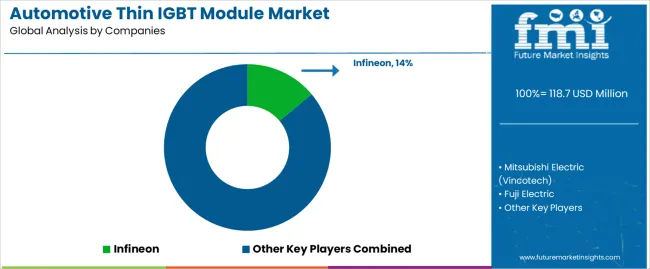
| Stakeholder | What they actually control | Typical strengths | Typical blind spots |
|---|---|---|---|
| Global semiconductor leaders | Technology development, broad product portfolios, automotive qualification | Wide automotive reach, proven quality, multi-region automotive support | Product refresh cycles; customer dependency on automotive validation |
| Technology innovators | Semiconductor R&D; advanced module technologies; enhanced performance properties | Latest technologies first; attractive ROI on efficiency effectiveness | Service density outside core regions; automotive scaling complexity |
| Regional automotive suppliers | Local automotive compliance, fast delivery, nearby customer support | "Close to customer" support; pragmatic pricing; local automotive regulations | Technology gaps; talent retention in automotive service |
| Integrated solution providers | Complete power systems, thermal management, automotive integration | Lowest operational risk; comprehensive automotive support | Service costs if overpromised; technology obsolescence |
| Niche automotive specialists | Specialized automotive applications, custom modules, OEM services | Win premium automotive applications; flexible configurations | Scalability limitations; narrow automotive focus |
| Item | Value |
|---|---|
| Quantitative Units | USD 118.7 million |
| Voltage | Less than 600V, 600V to 1200V, 1200V to 1700V, 1700V to 3300V, More Than 3300V |
| Application | Electric Vehicles (ev), Hybrid Electric Vehicles (Hev), Plug-in Hybrid Vehicles (PHev), Commercial Electric Vehicles |
| End Use | Automotive OEMs, Tier-1 Suppliers, Power Electronics Manufacturers, Electric Vehicle Startups, Commercial Vehicle Producers |
| Regions Covered | North America, Latin America, Western Europe, Eastern Europe, East Asia, South Asia Pacific, Middle East & Africa |
| Countries Covered | China, India, Germany, Brazil, United States, United Kingdom, Japan, Canada, France, Australia, and 25+ additional countries |
| Key Companies Profiled | Infineon, Mitsubishi Electric (Vincotech), Fuji Electric, Hitachi Power Semiconductor Device, Bosch, Onsemi, Toshiba, Microchip, STMicroelectronics |
| Additional Attributes | Dollar sales by voltage and application categories, regional adoption trends across East Asia, Europe, and North America, competitive landscape with semiconductor manufacturers and automotive suppliers, automotive manufacturer preferences for module effectiveness and power conversion, integration with automotive platforms and thermal management systems, innovations in semiconductor technology and module enhancement, and development of advanced module solutions with enhanced performance and automotive optimization capabilities. |
The global automotive thin IGBT module market is estimated to be valued at USD 118.7 million in 2025.
The market size for the automotive thin IGBT module market is projected to reach USD 626.5 million by 2035.
The automotive thin IGBT module market is expected to grow at a 18.1% CAGR between 2025 and 2035.
The key product types in automotive thin IGBT module market are 600v to 1200v, less than 600v, 1200v to 1700v, 1700v to 3300v and more than 3300v.
In terms of application, electric vehicles (ev) segment to command 19.5% share in the automotive thin IGBT module market in 2025.






Full Research Suite comprises of:
Market outlook & trends analysis
Interviews & case studies
Strategic recommendations
Vendor profiles & capabilities analysis
5-year forecasts
8 regions and 60+ country-level data splits
Market segment data splits
12 months of continuous data updates
DELIVERED AS:
PDF EXCEL ONLINE
Automotive Seating Market Size and Share Forecast Outlook 2025 to 2035
Automotive Appearance Chemical Market Size and Share Forecast Outlook 2025 to 2035
Automotive Remote Diagnostic Market Size and Share Forecast Outlook 2025 to 2035
Automotive-grade Inertial Navigation System Market Size and Share Forecast Outlook 2025 to 2035
Automotive Hydrogen Leak Detection Sensors Market Size and Share Forecast Outlook 2025 to 2035
Automotive Exhaust Extraction Hose Reels Market Size and Share Forecast Outlook 2025 to 2035
Automotive Electroplating Service Market Size and Share Forecast Outlook 2025 to 2035
Automotive Manufacturing Equipment Market Size and Share Forecast Outlook 2025 to 2035
Automotive Pressure Sensor Market Size and Share Forecast Outlook 2025 to 2035
Automotive Vacuum Brake Booster Market Size and Share Forecast Outlook 2025 to 2035
Automotive Smart Antenna Market Size and Share Forecast Outlook 2025 to 2035
Automotive Actuator Market Size and Share Forecast Outlook 2025 to 2035
Automotive Exhaust Manifold Market Size and Share Forecast Outlook 2025 to 2035
Automotive Roof Rails Market Size and Share Forecast Outlook 2025 to 2035
Automotive Resonator Market Size and Share Forecast Outlook 2025 to 2035
Automotive Counter Shaft Market Size and Share Forecast Outlook 2025 to 2035
Automotive Wheel Coating Market Size and Share Forecast Outlook 2025 to 2035
Automotive Water Separation Systems Market Size and Share Forecast Outlook 2025 to 2035
Automotive Refinish Coating Market Size and Share Forecast Outlook 2025 to 2035
Automotive Emission Test Equipment Market Size and Share Forecast Outlook 2025 to 2035

Thank you!
You will receive an email from our Business Development Manager. Please be sure to check your SPAM/JUNK folder too.
Chat With
MaRIA